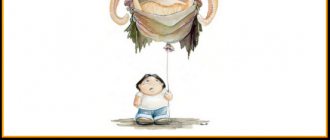Nancy McWilliams described various personality types in her publication Psychoanalytic Diagnostics. I propose to move on to considering the schizoid personality type.
The article will be of interest not only to psychologists, but also to those who study the human psyche. I would also like to draw the attention of those who are planning to make an appointment with an individual psychologist to this series of articles.
Psychological characteristics of the schizoid personality type
The leading psychological defense for this category of people is withdrawal into fantasy. Thinking creatively about the world is not always an escape from reality. If real life is replaced by an illusion, then this can be considered as one of the signs of this type of personality.
Schizoids are mainly attracted to theoretical, humanities, philosophy, and creative professions that require creativity and an individual mode of activity.
These people are rather introverted, their inner world is wide and multifaceted, among them there are many geniuses, hermits, and extraordinary personalities.
Schizoidia and its manifestations
Typically, schizoid personality is called schizoid accentuation. The difference between schizoid personality accentuation and SPD is that accentuation does not affect all aspects of a person’s life. Personalities of the schizoid type need communication somewhat less than ordinary people. However, the degree of socialization of people with schizoidia is not impaired. It is important that people with schizoid accentuation are able to adapt to a changing environment and show abilities in the field of social interaction when this turns out to be necessary. Schizoid character traits of a person with schizoid accentuations are manifested only in stressful situations.
Drives, affects, temperament of schizoid personalities
They tend to describe themselves as sensitive. Their sensitivity borders on the psychic.
Children may avoid contact with adults. Tend to form a schizoid structure. Difficulties arise at the oral level - they are afraid of being absorbed, eaten.
Projections and transformations of one's own hunger during fantasies of absorption. Schizoids perceive space as consuming and dangerous. They tend to withdraw, avoid, and reject the physical world.
Schizoids in most cases are not aggressive, although their fantasies may contain violence. Essentially, these people are soft and calm. They prefer horror films and apocalyptic scenarios. Calmly-minded eccentrics.
About schizoids, we can say that these individuals buried their aggression under a thick blanket of psychological defenses. Exposure to emotional reactions can affect their mood in different ways.
Alienation is a classic way of behaving when interacting with other people. However, they may feel that they are underestimated.
Schizoids are not empathetic enough to the less vibrant world of other people. Their perception may differ from most standard positions.
The schizoid personality type suffers from anxiety about personal safety. They are not gullible. There are many hermits among them. We can say about them that they are observers, researchers of human existence.
Schizoids experience a split between their own “I” and the world around them, between the experience of their own “I” and desire. Detachment from some part of oneself, life in general, is a common way of perceiving reality.
When splitting, a person expresses either one Ego state or the exact opposite. Divides the world into absolutely good and absolutely bad aspects. Moreover, over time, these positions may change.
What to do?
If you are in a relationship with a schizoid
You can invest your psychic energy in a relationship, but it will always be a “one-sided game” - you will not receive the necessary emotional response in return. The feeling of a fish hitting the ice very often accompanies partners of schizoids.
When a person with schizoid accentuation is suffering, you may try to give him support, but he will contradictively withdraw. Moreover, this is not narcissistic counterdependence (the “catch me” game), but an attempt to move to a safe distance in order to preserve one’s personality from the “invaders”. When he sees that you feel bad, he thinks that the best thing he can do is move away from you. Leaving you alone with feelings of abandonment and rejection. By and large, he exposes you to the same retraumatization that he himself experienced in early childhood.
How then to deal with them?
- Give him more personal space. Don’t try to quickly have frank conversations and close the distance - this can be intimidating. Stay in “pre-contact” for the amount of time he needs to build trust.
- Find an indirect way to talk about feelings. People of the schizoid type find it very difficult to show their emotions, even if they want to. Try to find an allegorical way to discuss what is important: talk about films, paintings, music, refer to symbols, metaphors and literary images.
- Be honest and truthful. Schizoids cannot stand lies and sense insincerity well.
- Help him recognize emotions. Learning to manifest them, to be aware of them, to differentiate them is one of the main skills that can dramatically change their life.
- Do not judge him for his desire to hide in his inner “house”. It is extremely important for him to know that he has you, but it is also important to maintain his autonomy. Let him understand - “you can leave me, but I will wait for you.”
- He will make the one who has passed all the cordons of his seemingly impenetrable borders very significant for himself. You will become one of the chosen ones whom he will let into his world. However, the game should be worth the candle: both should carry out the internal work in a couple. And your schizoid partner, first of all, is the one who hurts you with his emotional unavailability.
If you yourself have a schizoid personality type
The main thing you can do to help yourself (and your partner who is having a hard time) is to consult a psychotherapist in a timely manner. Drug therapy is ineffective here, but other therapeutic techniques (for example, exposure) work well.
A specialist will help you restore contact with your own emotions (mainly fear, anger and shame), develop the ability for emotional intimacy and teach you the ability to withstand various feelings, extracting from them a resource for your own development. After all, the ability to build close relationships is one of the most important indicators of a person’s mental health.
Here you can see a psychologist.
Photo: Unsplash.com
Protective and adaptation processes in schizoid personality types
The leading mechanisms for these individuals are withdrawal into the inner world, the world of imagination. Or positioning oneself in opposition to some social positions. They have a personal opinion on all issues. For example, if most people have a fashionable ringtone on their mobile phone, then schizoids will definitely play something distant, unpopular, and without mass recognition and veneration.
Psychological defense mechanisms: introjection, avoidance and intellectualization are leading among schizoids.
Creative. Among the schizoid personality type you can meet many talented and extraordinary people. They may say about them: “Not of this world.”
Story
The term “schizoid” was first used by Bleuler (1924), who described a “closed,” suspicious, sad person whose energy is directed inward rather than outward. This individual also demonstrated social withdrawal and odd thinking, but was not psychotic (Siever & Gunderson, 1983). A few years earlier, Hoch (1909) also described a “closed” personality that preceded the development of schizophrenia. The personality of these patients in the premorbid period was characterized by a tendency to solitude, shyness, stubbornness and rich imagination. Hoch and Polatin (1939) later described this group of nonpsychotics predisposed to developing schizophrenia as “pseudoneurotic schizophrenics.” Nannarello (1953) reported that the term was later popularized by Kretschmer (1925), who described “affective impairment” in two types of schizoid personality, “hyperaesthetic” and “anesthetic.” Kretschmer described the anesthetic schizoid personality as a dull, colorless, quiet, withdrawn person who rarely or does not show his emotions and interests.
In contrast, hyperaesthetic people are shy and so sensitive to external stimuli that they try to avoid them at all costs. From Kretschmer's point of view, a schizoid diagnosis does not necessarily equate to disability. Millon (1981) suggests that in modern terminology, the hyperaesthetic type would correspond to avoidant personality disorder, and the anesthetic type would correspond to schizoid personality disorder.
As noted by Siever & Gunderson (1983), the term "schizoid" has expanded from its original meaning to include people who avoid relationships and social interactions and tend to be eccentric. Widespread use of the term has overshadowed its original meaning as a non-psychotic form of schizophrenia. But it was not until 1953 that Raido coined the term "schizotypal" as short for "schizophrenic genotype." He was referring to people who he believed were genetically predisposed to schizophrenia but did not exhibit psychotic behavior. Rado's description of a schizotypal person included complete indifference to the joys of life, emotional coldness, impaired empathy and dependence. Although Raido intended to describe a non-psychotic form of schizophrenia, his description (apart from addiction) is very similar to the modern diagnosis of schizoid personality disorder.
Meehl (1962) later described a personality type similar to schizotypal personality disorder, which he believed was genetically related to schizophrenia. This group was characterized by cognitive decline, withdrawal from social contacts, complete indifference to the joys of life and ambivalence. This personality type typically showed low levels of adjustment, but eccentricity in thinking, behavior, and emotions, as described by Meehl, were not the main characteristics of this disorder. Kety, Rosenthal, Wender, & Schulsinger (1968) described “borderline schizophrenia,” also similar to schizotypal personality disorder, as a nonpsychotic personality disorder involving cognitive distortions, complete indifference to the joys of life, emotional coldness and lack of interpersonal skills. Siever and Gunderson (1983) note that this personality type is characterized by a paucity of interpersonal relationships rather than by social isolation and withdrawal (consistent with modern diagnoses of avoidant and schizoid personality disorders).
Because of the vagueness of these disorders and the changes in views on them over the years, the corresponding diagnoses have changed over time. In the DSM-I, schizoid personality was characterized by avoidance of relationships with others, an inability to express hostility or aggressive feelings, and autistic thinking. This description of a cold, emotionally detached, timid personality who could exhibit eccentricities appears to fit modern diagnoses of avoidant, schizoid, and schizotypal personality disorders. It was only in DSM-III that these disorders were separated. When developing new criteria, Millon (1969) emphasized the difference between the two personality types. He labeled them the “passive-avoidant” and “active-lonely” types or the “asocial” and “avoidant” types, which correspond to the modern diagnoses of schizoid and avoidant personality disorders (Millon, 1981). Although the term "schizoid" has a complicated history, it has remained a label for "asociality." This was supposed to be different from antisocial personality disorder. The schizotypal pattern, also included in the DSM-I and DSM-II descriptions of schizoid personality, was considered a separate personality type. Schizotypal and borderline personality types were then distinguished (Spitzer, Endicott, & Gibbon, 1979).
While early theorists such as Bleuler and Kretschmer believed that schizoid personality was due to constitutional problems, later psychoanalytic theorists hypothesized that schizoid character structure resulted from serious disturbances in the mother-child relationship. In psychoanalytic terms, as a result of these early disturbances, the schizoid person developed a primary defense structure in which relationships were avoided due to an inability to give or receive love. Moreover, this type of patient was thought to be so vulnerable to rejection that the value of relationships with people was suppressed (Arieti, 1955). Fairbairn (1940) reported that the result of these unsatisfying maternal relationships was the development of depersonalization and an artificial self in which feelings were repressed. The schizoid personality is unable to experience love and intimacy. Klein (1952) viewed the schizoid process as a developmental stage that all children go through. During this stage, oral and sadistic urges, experienced as dangerous, are separated and projected onto the caregiver. In this case, the caregiver is considered dangerous, and various defenses are formed to overcome the anxiety that arises in this regard. The schizoid adult, retaining some of these early defenses, maintains distance in interpersonal relationships due to anxiety caused by interpersonal contacts. Guntrip (1969) also described developmental delays in early life when children avoid an unsatisfying relationship with their mother. These people subsequently develop a primitive fear of consuming people or being consumed by a caregiver. This leads them to develop a reserved and aloof interpersonal style as a defense against primary horror and anger.
Psychoanalytic theorists, in addition to distance in interpersonal relationships, also pay attention to the defensive, detached, “observer” style seen in schizoid individuals. Deutsch (1942) reported that an “as if” personality is formed, so it is impossible to feel emotions. The observer may see that the life of schizoids “seems” to be fulfilling, but upon closer examination, a lack of emotional reactivity will be obvious.
In contrast to the complex intrapsychic mechanisms proposed in psychoanalysis, Millon (1981) stated that the schizoid personality has a relatively simple defense structure. He believes that schizoid people suffer from a lack of ability to form relationships and experience emotions. As a result of this insensitivity to interpersonal contacts and emotional stress, there is no need to develop defenses.
Object relations
The subjective life of schizoids is permeated with ambivalence regarding attachment. They crave intimacy even though they feel threatened by others. They seek distance to maintain their safety, but at the same time suffer from remoteness and loneliness.
The message of schizoids to the world looks something like this: “Come closer, I’m lonely, but stay at a distance, I’m afraid of being absorbed by you!”
These people are often indifferent to sex, but are able to have an orgasm; physiologically they are completely healthy. Selective in choosing partners, it takes more time to “warm up”. The closer the other person is, the more they perceive that sex means a trap. They are wary of any new connections. However, they may desire unattainable sexual objects, but are indifferent to the available ones.
The upbringing of these individuals could proceed in the pattern of “a schizoid man and an over-caring, suffocating mother.” Mom, most likely, “ruled the show” and controlled all processes in the family. A boundary-violating mother and an impatient, critical father. The child may be in a state of double clamping and emotionally false messages. We depend on care to protect our own “I” from approaching them. The double clamp manifests itself in the fact that one message is demonstrated verbally, and the child perceives another non-verbally. "I love you very much!" mother tells her little son, who has been waiting for her from work for a long time. And non-verbally, she strives to quickly complete communication with him simply because she is tired. The child is confused about which signal to perceive as reliable.
The childhood of schizoids is characterized by loneliness and isolation. Parents are distant, manifest themselves as oppressive and intruding, and a pattern of avoidance, distancing, and detachment is formed. Such children, and subsequently people, do not like to openly discuss their thoughts with someone or share their impressions. They do not like attention from society.
University
→ Home → University → University in the media → 13 psychotypes of personality: from paranoid to cycloid
They say there is a scale of psychotypes. How can you find out how your own child is growing up in order to help him fight his negative traits? Zinaida K., Gomel.
The classification of accentuations was developed by the German psychiatrist Karl Leonhard in 1968. Based on his works and the research of Russian psychiatrist Pyotr Gannushkin, Soviet psychiatrist, Honored Scientist Andrei Lichko created his own personality typology.
PARANOID
Traits of this psychotype rarely appear in childhood; the guys are focused on one thing, serious, preoccupied, striving to achieve what they want at any cost.
Dominant character trait: high degree of determination. Such teenagers subordinate their lives to achieving a goal (quite large-scale), while being able to neglect the interests of others. They are ready to sacrifice well-being, give up entertainment, comfort and other joys common to children.
Attractive character traits: high energy; independence; independence; reliability in cooperation when goals coincide with the aspirations of the people with whom they work.
Repulsive traits: irritability, anger, if something or someone gets in the way of the goal; weak sensitivity to other people's grief; authoritarianism.
The “weak link” of the psychotype: they are extremely ambitious in the grand scheme of things, not in small things.
Features of communication and friendship. When making contact, they often suppress their interlocutor, are overly categorical in their judgments, and can hurt others with their words. They don’t notice their own conflict. Completely unsentimental, friendship is viewed as a continuation of a common great cause. Friends are only comrades.
Attitude to study and work. Only those subjects that are needed now or will be needed in the future are carefully studied. To do this, they can go to the library, take extra classes, buy a lot of books, and read during breaks. And everything else in school is of no value. The greatest success is achieved in individual creative work. Unsurpassed generators of big ideas and non-standard approaches to solving complex problems. EPILEPTIOID From preschool age, children predisposed to this type are thrifty with clothes and toys. They react sharply to those who try to take possession of their property; From the first school years they show increased accuracy.
Dominant character traits: love of order, desire to maintain what has already been established, conservatism; high energy (students willingly engage in physical education, run, speak loudly, organize everyone around them, and with their activity often disturb others). In extreme situations, teenagers become brave and even reckless; in everyday life they show anger, explosiveness, and pickiness.
Attractive character traits: thoroughness, accuracy, diligence, frugality (often turning into pedantry), reliability (always keep promises), punctuality (in order not to be late, they will set 2 alarm clocks and also ask their parents to wake them up), attentiveness to health.
Repulsive character traits: insensitivity to the grief of others, excessive irritability due to noticed disorder, carelessness of others, or violation of rules.
The “weak link” of the psychotype: they cannot tolerate disobedience and violently rebel against infringement of their own interests.
Features of communication and friendship. They do not make casual acquaintances; they prefer to communicate with childhood friends and schoolmates. If they consider someone a friend, then they fulfill all the obligations that friendship imposes. Betrayal, either in friendship or in love, will never be forgiven.
Attitude to study and work. They are goal-oriented, complete all homework, do not skip classes, and are usually excellent students. Growing up, they perform best in work related to maintaining order, rules and regulations adopted by someone else (for example, a financier, lawyer, teacher, military man, etc.). HYPERTIME Those belonging to this psychotype have been distinguished since childhood by their noisiness, sociability, and courage; prone to mischief. They lack a sense of distance in relationships with adults.
Dominant character traits: high spirits, extroversion, joy from communication, good health and blooming appearance.
Attractive character traits: energy, optimism, generosity, desire to help people, initiative, talkativeness, cheerfulness; the mood is almost independent of what is happening around.
Repulsive character traits: superficiality, inability to concentrate on a specific task or thought, constant desire to do something more interesting at the moment, jumping from one thing to another (such guys sign up for several clubs or sections at once, but none for longer than 1– They haven’t walked for 2 months), disorganization, familiarity, frivolity, readiness to take unrestrained risks.
The “weak link” of the psychotype: cannot tolerate a monotonous environment, monotonous work that requires painstakingness or a sharp limitation of communication; they are oppressed by loneliness and forced idleness.
Features of communication and friendship. They always act as merry fellows and jokers. Their home is a meeting place for friends and acquaintances, where anyone can come and stay as long as they like. They are always drawn to the company and strive for leadership among their peers. They can easily find themselves in an unfavorable environment and are prone to adventures. They are not capable of deep affection. They are characterized by love for their neighbor (and not for all humanity); rush to help without hesitation. In friendship they are kind and unforgiving. Having offended someone, they quickly forget about it and will be sincerely happy the next time they meet; if necessary, they will apologize for the offense caused and do something nice.
Attitude to study and work. Schoolchildren of this psychotype would achieve significant success if they were not so frivolous and could concentrate on one subject. All subjects are easy for them, but the knowledge they receive at school is superficial and often unsystematic. They are constantly late for classes and skip classes (especially those classes in which they are bored and have no opportunity to express themselves). It’s easy to catch up on lost time: for example, before a test or exam, they don’t sleep for one night and learn almost everything.
Capable of achieving success in any business. At first, everything goes well for them, achievements appear, but if routine work begins, it becomes uninteresting, the activity ceases to be new, then they are ready to quit at the first opportunity and switch to something else.
Noisy and overactive, they often create the appearance of productive activity (they willingly and eagerly get down to business, plan a lot of events, hold meetings, etc.), which helps to advance their career.1
HYSTEROID
This psychotype is visible from early childhood. A cute baby, in front of a large number of adult strangers, recites poems, sings songs, and demonstrates his talents and outfits without any embarrassment. The main thing for him is admiring spectators. If guests sat down at the table and forgot about it, it will certainly attract attention again. If unsuccessful, he will knock over a glass on the tablecloth or break a saucer.
Dominant character traits: demonstrativeness; the desire to constantly be the center of attention, sometimes at any cost; thirst for constant admiration or surprise, veneration, worship.
Attractive character traits: perseverance, initiative, sociability, dedication, resourcefulness, activity, pronounced organizational skills, independence and willingness to take leadership (although after a burst of energy, the listed qualities quickly fizzle out).
Repulsive character traits: a tendency to intrigue and demagoguery, hypocrisy, cockiness, recklessness, thoughtless risks (but only in the presence of spectators), boasting about non-existent successes, taking into account only one’s own desires, inflated self-esteem, touchiness.
The “weak link” of the psychotype: inability to withstand blows to egocentrism, exposure of fictions.
Features of communication and friendship. They constantly need numerous viewers. In principle, this is the main form of their life (in public and for people). But, as a rule, they communicate only with those who express their admiration and idolize their abilities and talent. Very often they are selective, striving to be friends with famous people in order to be in the shadow of their fame, or with those who lose to them in order to shade themselves even more.
Attitude to study and work. Often this is just a reason for communication, an opportunity to express yourself among people. They go to school for fun. To attract attention, they study not just well, but better than anyone else, surprising teachers with their abilities in various subjects. In principle, these are gifted, talented people who are easily given professions related to artistic creativity. They work best outside the team and outside the mandatory framework. SCHIZOID Since school years, such children like to play alone, are not drawn to classmates, avoid noisy fun, preferring the company of older children. In adolescence, isolation and isolation, and an inability to empathize with others are striking.
Dominant character trait: introversion. This is a pronounced mental type, constantly analyzing the surrounding reality.
Attractive character traits: seriousness, restlessness, taciturnity, stability of interests and constancy of activities. As a rule, these are talented, smart and unpretentious schoolchildren. Productive, they can work on their ideas for a long time, but do not push through them, do not implement them.
Repulsive character traits: isolation, coldness, rationality. Such children have low energy and are inactive during intensive work - both physical and intellectual. Emotionally cold. Their egoism is unconscious. At the same time, they are vulnerable, because they are proud. They do not tolerate criticism of their system.
The “weak link” of the psychotype: they cannot tolerate situations in which it is necessary to establish informal emotional contacts, and the violent invasion of strangers into their inner world.
Features of communication and friendship. Very selective; people are hardly noticed, like many things in the material world. But they still need communication that is deep and meaningful. The circle of people with whom they come into contact is limited (as a rule, they are older). They are characterized by self-sufficiency in the sphere of relationships; they can communicate with themselves or with one person. A friend is one who understands their characteristics well and does not pay attention to oddities, isolation and other negative character traits.
Attitude to study and work. They are capable and talented, but require an individual approach, since they have a special vision of the world, their own point of view on ordinary phenomena and objects, unlike others. They know how to study a lot, but not systematically, because it is difficult to fulfill generally accepted requirements, and not according to the scheme they themselves invented. When they see that a teacher evaluates the result of work, and not formal compliance with mandatory rules, they show all their talent. If the teacher and parents require children of this psychotype to solve problems in a strictly defined way (as explained in class), then they will fall behind, despite the fact that they are quite capable of solving the same problems in several original ways. This applies not only to mathematics, but also to other academic subjects. Most often, such guys make excellent scientists, for example mathematicians or theoretical physicists. PSYCHASTENOID Along with some timidity and timidity, such children have a tendency to reason and have intellectual interests that are beyond their age. From a young age they suffer from various phobias - fear of strangers, new objects, darkness, being alone at home, etc.
Dominant character traits: uncertainty and anxious suspiciousness, fear for one’s future and loved ones.
Attractive character traits: accuracy, seriousness, conscientiousness, prudence, self-criticism, even mood, loyalty to promises, reliability.
Repulsive character traits: indecisiveness, a certain formalism, a tendency to long discussions, self-examination. There may be fears regarding an unlikely future, based on the principle “no matter what happens” (hence the belief in omens). Another form of protection against constant fears is conscious formalism and pedantry, which are based on the idea that if everything is carefully thought out in advance, foreseen and then acted without deviating a single step from the planned plan, then troubles can be avoided. Such teenagers find it difficult to make decisions; they constantly doubt: have they taken everything into account? But if they dare, they begin to act immediately, because they are afraid that they will change their mind.
The “weak link” of the psychotype: fear of responsibility.
Features of communication and friendship. They are shy, self-conscious, and do not like to make new contacts. They have few friends, but this friendship lasts forever. They remember the smallest details of the relationship and are sincerely grateful for your attention.
Attitude to study and work. They are able to study without raising their heads, showing determination, perseverance and perseverance for a long time, because they are afraid of upsetting their loved ones and teachers with low grades. The result obtained is checked against reference books, dictionaries, and encyclopedias; They'll call a friend and ask him.
These are ideal subordinates: they will complete any work carefully, accurately and on time, if the task is specific and there are instructions clearly regulating the procedure for its implementation. Such people like a quiet profession, for example, a librarian, accountant, or laboratory assistant. SENSITIVE From the first steps, these guys are fearful, afraid of loneliness, darkness, animals, especially dogs. They avoid active and noisy peers, but are sociable with those they are accustomed to; They love to play with kids: they feel confident and calm. They are very attached to their family and friends, these are “home children”: they try not to leave their native walls, they do not like to visit, much less travel somewhere far away (for example, to another city, even if their beloved grandmother lives there).
Dominant character traits: increased sensitivity, impressionability. Children are timid and shy, especially among strangers and in unusual surroundings. They see many shortcomings in themselves.
Attractive character traits: kindness, calmness, attentiveness to people, a sense of duty, high internal discipline, responsibility, conscientiousness, self-criticism, increased demands on oneself. They strive to overcome their weaknesses.
Repulsive character traits: suspiciousness, fearfulness, isolation, a tendency to self-flagellation and self-humiliation, confusion in difficult situations, increased sensitivity and conflict on this basis.
The “weak link” of the psychotype: they cannot tolerate ridicule or suspicion from others of unseemly actions or unkind attitudes.
Features of communication and friendship. They contact with a narrow circle of people who arouse their sympathy. They avoid meeting and communicating with the lively and restless in every possible way. They prefer to share experiences and sensations with old friends.
Attitude to study and work. They study because they do not want to upset their relatives and teachers. They are embarrassed to answer at the board, they are afraid that they will be called an upstart. With a friendly attitude from teachers, they show excellent results. For them, work is something secondary; the main thing is warm and kind relationships with colleagues and the support of their manager. They can be executive and devoted secretaries, assistants, etc. HYPOTHYMOUS They do not show much joy, they are offended by everyone, especially by their parents. There is an expression of dissatisfaction on their faces, frustration because they did not do it the way they wanted.
Dominant character trait: always in a minor key.
Attractive character traits: conscientiousness, keen critical view of the world. They strive to be at home more often, to create comfort and warmth, thereby avoiding unnecessary worries.
Repulsive character traits: touchiness, vulnerability, despondency, tendency to look for illness in oneself, almost no interests and hobbies. Fast fatiguability.
The “weak link” of the psychotype: open disagreement with a different perception of reality.
Features of communication and friendship. Often and for a long time they are offended by others and friends, although they urgently need communication, so that they have someone to complain about life, about the fact that they were not understood or appreciated. I like to talk about the difficult circumstances in which I found myself. The advice of your interlocutor will be answered with a lot of arguments why nothing can be changed and it will only get worse.
It is difficult to be friends with such children: they see in any person a possible reason for the deterioration of their mood.
Attitude to study and work. They prove themselves by memorizing the material well and carefully completing assignments, but they are not particularly interested in the depth and content itself. They study for fear of a bad grade. Citing illness, they may skip classes, most often in physical education, labor training and other subjects, the teachers of which do not make allowances for a bad mood.
It happens that they complain about people, circumstances, and ask to be given another task. But everything repeats itself: shortcomings, negative aspects in the organization of production or traits in others - a whole uprising in the soul. It's hard to do one thing all the time.
CONFORMAL TYPE
This type is quite common. Children agree with everything that their immediate environment suggests, but as soon as they come under the influence of another group, they change their attitude towards the same things to the opposite. They lose their personal attitude towards the world - judgments and assessments will coincide with the opinions of those with whom they communicate at the moment. Moreover, they do not stand out, do not impose their opinions, representing the masses who agree with the leader.
Dominant character traits: excessive adaptability to the environment, almost complete dependence on family and company. Life flows under the motto: “Think like everyone else, do like everyone else, and so that everything is like everyone else.” This extends to clothing style, behavior, and views on important issues. These teenagers become attached to their peer group and unconditionally accept its value system without criticism.
Attractive character traits: friendliness, diligence, discipline, flexibility. They will not be a source of conflict or discord. They listen to the guys’ stories about “exploits”, agree with proposals from leaders, willingly participate in “adventures”, but then they can repent. They lack their own courage and determination. If the micro-team seems significant and has a positive orientation, then together with it they can achieve serious success, for example, by studying in some section.
Repulsive character traits: lack of independence, almost complete lack of criticism towards oneself and the immediate environment.
The “weak link” of the psychotype: they cannot tolerate drastic changes or breaking the life stereotype.
Features of communication and friendship. They easily establish contacts with people and at the same time imitate leaders. Friendly relationships are fickle and depend on the current situation. They do not strive to excel among friends and do not show interest in making new acquaintances.
Attitude to study and work. If everyone around them studies well, then they will make an effort to keep up with their friends. The attitude towards work also depends on the mood of the team; are able to demonstrate diligence, diligence, creativity and ingenuity, and carry out everything that is assigned. Or they may shirk or do work formally if there are slackers nearby.
UNSTABLE TYPE Since childhood, they are disobedient, restless, climb everywhere, but at the same time they are afraid of punishment and easily obey their peers.
Dominant character traits: complete inconstancy of manifestations, dependence on any person who is nearby at that moment. Easily influenced.
Attractive character traits: sociability, openness, helpfulness, goodwill, speed of switching in business and communication. Often, outwardly, such teenagers are obedient, ready to fulfill the requests of adults, but their desires quickly disappear; very soon they forget about their word or are lazy, they come up with a lot of reasons why they cannot do what they promised.
Repulsive character traits: craving for empty pastime and entertainment, talkativeness, agreement, irresponsibility.
The “weak link” of the psychotype: neglect, lack of control.
Features of communication and friendship. Non-conflicting. Their contacts are pointless. They can be part of several groups at once, adopting the rules and style of behavior of each team. Tend to live for today; They sit for hours in front of the TV, listening to music. They act as assistants to leaders.
Attitude to study and work. Under the influence of another hobby, they may begin to study well or abandon their studies, which will inevitably lead to large gaps in knowledge. Further studies become more difficult. Their knowledge is unsystematic, their attention is unstable, and during lessons they are often distracted from work for a long time. Homework is done reluctantly. Such people do not make good specialists. ASTHENIC Since childhood, poor sleep, poor appetite, often capricious, afraid of everything. Sensitive to loud sounds, bright light; they quickly tire of even a small number of people; strive for solitude.
Dominant character traits: increased fatigue, irritability.
Attractive character traits: neatness, discipline, modesty, complaisance, diligence, friendliness, forgivingness.
Repulsive character traits: capriciousness, self-doubt, lethargy, forgetfulness. Such teenagers are timid, shy, have low self-esteem, and cannot stand up for themselves. They experience great anxiety when external circumstances change and stereotypes are broken, because their psychological defense mechanism is getting used to things and their way of life.
The “weak link” of the psychotype: sudden affective outbursts due to severe fatigue and irritability.
Features of communication and friendship. They do not strive for close relationships due to uncertainty and do not show initiative. The circle of friends is limited.
Attitude to study and work. Low self-esteem often gets in the way. Constant doubts, feelings of anxiety and fear of making a mistake prevent you from working normally in class or answering at the board, even when the material has been learned. Work is tiring and does not bring joy or relief. Heavy and tense causes irritation. They need periodic rest or alternation of different types of activities.
LABILE TYPE They often catch colds. They are capable of getting upset because of an unflattering word, an unfriendly look, or a broken toy. Pleasant words, a new suit or book, good news quickly lift your spirits and give a cheerful tone to the conversation, but at any moment another “trouble” can change everything.
Dominant character trait: extreme mood swings from insignificant reasons. The state of mind determines everything: appetite, sleep, general well-being, desire to communicate, learn, performance.
Attractive character traits: good nature, sensitivity, affection, sincerity, responsiveness (during periods of high spirits). Loyalty to those with whom you are on good terms, who are loved and cared for. Moreover, this attachment remains, even if the mood has changed.
Repulsive character traits: irritability, short temper, pugnacity, weakened self-control. During a normal conversation, they can flare up and say something impudent and offensive.
The “weak link” of the psychotype: emotional rejection of significant people, loss of loved ones or separation from those to whom they are attached.
Features of communication and friendship. It all depends on my mood. If you are happy and satisfied with life, then you establish contacts with great desire; if you are upset and not satisfied, then they are minimal. They have developed intuition and easily determine a “good” and a “bad” person when choosing a friend. They prefer to be friends with those who, during periods of low mood, know how to distract, console, tell something interesting, protect in the face of attacks from others, and, in moments of emotional upsurge, share wild joy and fun. Capable of loyal friendship.
Attitude to study and work. Characterized by extreme variability; They react unpredictably to remarks and requests from the teacher or parents: in response to a remark they are able to laugh and joyfully begin to correct the mistake, but tears, irritation, and reluctance to obey the legitimate demands of the teacher are quite possible. Knowledge is superficial and unsystematic, because such teenagers do not manage themselves and cannot be controlled by adults. They switch gears, forget about their bad mood, if the work interests them, doesn’t get boring, and captivates them. CYCLOID These schoolchildren are no different from their peers, but from time to time they are unusually noisy, mischievous, and are constantly doing something. Then they become calm and controlled again. Adolescents experience periodic phases of mood swings, the duration of which ranges from several days to a week or more.
Dominant character trait: cyclical changes in the emotional background (high mood disappears, emotional decline puzzles everyone).
Attractive character traits: initiative, cheerfulness, sociability, when your soul is good.
Repulsive character traits: inconsistency, imbalance, indifference, outbursts of irritability, excessive touchiness and pickiness towards others. If you are overcome by sadness, then everything falls out of your hands; What was easy yesterday requires incredible effort today. During a recession, it is more difficult to live, study, and communicate. Companies are annoying, risk, adventure, entertainment are losing their appeal. They become “homebodies” for a while.
Mistakes and minor troubles are very difficult to experience on pessimistic days. Just yesterday they won the tournament, but today the game isn’t going well, the coach is unhappy... It’s depressing, they don’t recognize their body, they don’t understand their irritation, they don’t want to see their loved ones. They respond to remarks and remarks with dissatisfaction, although deep down they are very worried about these sudden changes. There is no feeling of hopelessness; they are confident that after some time everything will be fine again. You just need to survive the recession period.
The “weak link” of the psychotype: emotional rejection by significant people, a radical break in life stereotypes.
Features of communication and friendship. Relationships with people are cyclical: the craving for communication, new acquaintances, reckless prowess are replaced by isolation, reluctance to talk even with parents and close friends (“I’m so tired of you all”). They are truly friends with those who understand this inevitability of change in relationships and are not offended and forgive outbursts of irritability and resentment.
Attitude to study and work. Periods of active work in the classroom and at home are followed by stages when complete indifference to anything sets in. In work, everything works out and works out as long as it’s interesting; as soon as the mood drops, they are dissatisfied with everything that is offered to them.
Based on the degree of severity, we can distinguish 2 types of character accentuations, which is necessary to know for an individual approach in raising a child, when choosing career guidance, forms of personal and family psychotherapy: • obvious accentuation - an extreme variant of the norm. Character traits are expressed throughout life; • hidden accentuation is a common variant of the norm. Some special character traits appear mainly during psychotrauma.+
These 2 types can transform into each other, which is influenced by family upbringing, social environment, professional activity, and physical health. In contrast to “pure” types, mixed forms of character accentuation are much more common. Natalya Grigorieva, Associate Professor of the Department of Psychiatry and Medical Psychology of BSMU, Candidate of Medical Sciences. Sciences Medical Bulletin , July 31, 2014
Share
Schizoid self
Schizoids, as a rule, do not care about the assessments of others. They do not accept conformity in others. These are not “collective people”; they view those who adapt to others as weak-willed and overly pliable. They don’t like small talk and consider it meaningless.
They may be slightly contemptuous of others and consider them not deep enough. This can lead to oppositional opinions. They may violate customs and norms that are established in a particular team. Avoid being defined and analyzed by other people.
Schizoid personality types are attracted to hysterical people, but when solving interpersonal problems, hysterical personalities try to get closer, and schizoid ones, on the contrary, try to move away.
They can be very caring towards others, but need to maintain their personal space.
A profession that allows you to get to know other people better and remain outside their interpretations is psychology. Schizoids may feel that psychologists have some power over other people in this regard.
Strives to find confirmation of his own originality and uniqueness. It should be internal rather than external. However, they can also be self-critical.
Development of schizoid states with age
Most often, the tendency to schizophrenia begins to actively manifest itself after 30 years. In severe cases, it is at this age that suicide attempts occur due to the exacerbation of depressive psychosis. However, if an individual has been in a socially disadvantaged environment for a long time, the features of the disorder can actively manifest themselves much earlier, already at school (adolescence). For example, if a teenage child lives in a family of drinking parents and is constantly exposed to violence from adults, he may become schizophrenic by the age of 20. The use of alcohol and drugs leads to the fact that schizophrenic deviations become significantly “younger”. This situation can be characterized as social schizophrenia.
In some cases, a person becomes ill after 50 years of age. The formation of the disorder often coincides with the main stressful situations of this age (retirement, separation from adult children, death of a husband or parents). In this case, the prognosis is most often unfavorable. The older the individual, the more difficult the disease is to treat.
Interesting. In women, the characteristics of schizoidity begin to actively manifest themselves at the age of 35 years. The peak of the disorder occurs during menopause, the so-called “menopause.”
Transference and countertransference
Schizoids avoid any form of intervention. The work of a psychologist should be structured in doses. However, with sufficient trust in the psychologist, they can create a fairly effective working alliance.
These clients may seek help because their isolation from society may be painful, or they may seek different social behavior.
One of the popular requests of schizoids to a psychologist is to work with depressive states. Or they may fear that they are on the path to madness, especially if those close to them do not understand the way they think or do not share their values.
A schizoid needs time to feel safe in a psychological setting.
It is important for a psychologist not to intrude and to work gradually with such clients. It is important to understand that it is often possible to hear complex, confusing messages from schizoids; they may not understand themselves.
Such a client may be afraid of emotional distance from the psychologist or other people. Although he prefers to leave them at some distance from himself.
They can present themselves in communications as an unattainable sage or an enlightened lama.
Description
There are two main features of schizoid personality disorder: a lack of interpersonal relationships and a lack of desire to establish such relationships. Other people are viewed as intrusive and unhelpful, and relationships with them are viewed as messy and undesirable. As a result, these people are often described as introverted, reclusive, and lonely. In accordance with this, they react little to both negative and positive feedback from others.
As you might expect, they get little satisfaction from relationships with people.
In addition, schizoid people are affectively limited and exhibit neither strong negative nor strong positive emotional reactions. According to this, Millon (1981) suggests that they are unable to recognize subtle emotions in both themselves and others. As a result, they often appear and feel uncaring. For many of these people, life is, at best, an unexciting endeavor.
Although schizoid individuals can be productive, they organize their lives to limit interaction with other people and usually choose professions that require minimal social contact. In addition, they act alone and outside the professional sphere.
Psychologist's work with schizoid personalities
When a psychologist works with schizoid individuals, it is important to demonstrate to the client that the psychologist does not want to impose or suppress. The first thing the psychologist does at the beginning of the session is to check the comfort of the distance between himself and the client, asking his opinion on this matter. This looks like adjusting the distance of chairs during a meeting.
In the early stages of working with schizoids, interpretations should be avoided, as the client experiences fear of being invaded.
Attempting to get more from a schizoid than he expresses can cause resistance in him and increase the tendency to withdraw or resist.
Remarks and comments should be using the expressions of the clients themselves, quoting. Then such clients will understand that their boundaries are not being violated.
It can be difficult for schizoids to believe that their acute reactions can be understood and accepted by other people, so they are quite careful when presenting them to others.
Schizoids may worry that they are fundamentally different and cannot be understood by other people.
Clients with a schizoid personality type are afraid that if their inner world is revealed and studied, they may appear to others as eccentrics or even freaks. They care about the effect they have on people moving away. For a schizoid personality, it is valuable when they are perceived as talented people.
The emotional reactions of schizoids throughout life have been anecdotal or downplayed by commentators. They could be told: “Don’t be stupid, be like everyone else! And in general, stop flying in the clouds and go get some bread.”
One of the ways for a psychologist to inform a schizoid that his problems or requests are understood can be through artistic images.
Schizoid clients, if they feel understanding on the part of the psychologist, expect to meet with him as a respite from the demanding world. Gaining trust is quite difficult, but if this happens, the work will be effective.
Although schizoids also experience insights during a psychological session: as a rule, social functions do not improve. For example, they may avoid marriage, sexual relationships do not improve, etc. When a psychologist reminds a schizoid that they are working on his socialization, this can be perceived as a violation of personal boundaries, control, and a lack of empathy for his need for boundaries. Although socialization could be a request for work in a psychological session.
One of the leading conflicts that the psychologist has to resolve together with the schizoid during the session is the desire for intimacy and the fear of its occurrence.
What is schizoid personality disorder (SPD)?
Schizoid personality disorder (SPD) is a pathological condition manifested by a combination of disharmonious characteristics of an individual, included in the DSM-5, ICD-10 and CCMD-3 classifiers.
They determine the personality structure, often congenital or acquired during life. Features of SPD are a tendency to immerse oneself in one's own fantasies, emotional alienation. Prevalence in the population is 3-5% (according to DSM-5). The final definition was introduced by Ernst Kretschmer in 1921. A German psychiatrist suggested a causal relationship between this personality disorder and schizophrenia. However, further foreign studies refute the theory. Domestic guidelines indicate that before the onset of the disease, approximately 40% of people had SPD.
Currently, the term “schizoid” is descriptive exclusively for this syndrome, that is, it is not identical to “schizophrenia.”
Facial expressions are devoid of liveliness and are limited to a set of standard expressions. The voice is little modulated, which is why the conversation is often conducted as if on one note. Clothing is stylized - it is either emphasized sophistication, aristocracy, or, conversely, deliberate negligence. Schizoids are people of extreme feelings and emotions; they either admire or hate. The hobbies of schizoids are most often peculiar, even original, and, as a rule, one-sided. The social significance of hobbies varies: for some, all their strength, thoughts and energy are directed towards achieving unimportant goals (for example, collecting); others, on the contrary, show remarkable energy and perseverance in creating sometimes very talented and valuable scientific concepts. However, in both cases, they remain completely indifferent to the needs of practical life, everyday interests, and the needs of the family.
Smulevich A.B. ‹‹Borderline mental disorders›› Schizoid personality disorder.
Psychological help
Psychotherapy is used to treat schizoid accentuation. The psychoanalytic approach, which involves long-term work by a psychologist, helps well. The specialist must act carefully, reducing the distance very gradually. You cannot focus the patient’s attention on his characteristics or emphasize his originality. To achieve the schizoid's favor, a demonstration of acceptance of his non-standard thinking is necessary.
Group therapy also works well; in these classes, individuals learn to accept themselves through the example of studying people like themselves. The environment should be as comfortable as possible and based on a feeling of complete safety. Of course, not all schizoid personalities can open up in the presence of strangers, but if you conduct such classes regularly, you can gradually achieve their participation in therapy.
Cognitive therapy is based on the experience of positive emotions. In this case, the patient must study the entire range of feelings and learn to understand each of them. Next, he must practice expressing positive emotions in life situations, as well as building friendly contacts. You need to start this kind of work in a familiar environment, but gradually leave your comfort zone.
To live comfortably next to a schizoid woman, and to communicate meaningfully with her, you need to find an approach to her. Treatment of people with the schizoid type is necessary only in cases where they have difficulties with social adaptation, problems with professional activities and personal life. In most cases, correction is not necessary.









